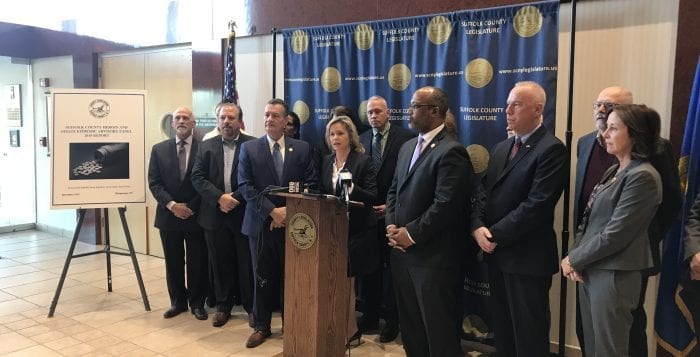Suffolk Sees Decrease in Fatal Opioid Overdoses, According to Annual Report

The opioid epidemic has hit Long Island hard over the past few years, but according to an annual county report, fatal opioid-related deaths have decreased significantly over the past year.
The Suffolk County Heroin and Opiate Epidemic Advisory Panel’s 2019 Report released Jan. 2 found that opioid deaths in 2019 were projected at 283, which was an approximate 25.5 percent decrease from the 2018 total of 380.
“We are moving in the right direction,” said Suffolk County Legislator Sarah Anker (D-Mount Sinai), the chair of the panel, at the Jan. 2 press conference in Hauppauge. “The opioid crisis is costing Long Island upward of $8 billion a year in medical costs … that’s $22 million a day. Not only do we have to address the addiction issue, we have to also address mental health.”
“The opioid crisis is costing Long Island upward of $8 billion a year in medical costs … that’s $22 million a day. Not only do we have to address the addiction issue, we have to also address mental health.”
– Sarah Anker
The 127-page report compiled by the 29-member panel highlights that the decreased numbers can be attributed to the increased use of Narcan, a drug that reverses the effects of overdoses.
Other highlights from the previous year includes the panel collaborating to help open a DASH Center, a 24/7 resource center for individuals in search of treatment and resources located at 90 Adams Ave., Hauppauge. The officials also purchased a mass spectrometer, a device that detects and breaks down the chemical compounds of drugs. The device is used to help track where drugs are coming from, making it easier to identify dealers.
Geraldine Hart, Suffolk police commissioner, said the force is focusing on addressing the drug dealer situation.
“We have seen a decrease in opiate usage but that is not enough,” she said. “We have a strategy that is taking hold, it involves enforcement, prevention, education and treatment.”
The panel’s report also lists resources for residents, including a number of counseling programs, agencies, drug treatment courts and law enforcement initiatives like Sharing Opioid Analysis & Research (SOAR).
The panel was created in 2017 in response to the growing opioid and substance abuse epidemic in Suffolk County and across the nation.
While deaths have decreased, the number of overdoses increased 140 percent from 71 to 170.
While members of the panel said the decrease in number of fatal overdoses is a great sign, the increasing number of overdoses not resulting in death is something that requires more investigation.
Jeffery Reynolds, president of the Family and Children’s Association, said the new data is encouraging but stressed that more needs to be done.
“These gains can sometimes be precarious — it took a long time for opioids to brew in this region, we were slow to respond in the region and nation, and we paid the price for it,” he said. “We gave heroin a 10-year head start. The last thing we want to do is declare victory prematurely.”
Reynolds said there is still a need for a DASH/recovery center on the east end of Long Island and that panel wouldn’t stop working until “the overdose number is at zero.”
William “Doc” Spencer (D-Centerport), Suffolk County legislator and chair of the health committee, said it is also important to make sure the medical community is part of the solution. He mentioned there needs to be more research on genetic predisposition and environmental triggers relating to drug use.
“There’s a lot of work to be done but this is a major step [in the right direction],”Spencer said.
Going into 2020, the panel will focus on addressing the following areas: the growing vaping epidemic, early education initiatives, childhood trauma intervention, possible marijuana legislation, the effects of recent bail reform laws, establishing a recovery high school, continuing overdose prevention discussions with the Metropolitan Transit Authority and Long Island Rail Road, increasing prescriber education, reducing the stigma of addiction and mental illness and collaborating with the Native American Advisory Board and establishing a youth committee.
Anker said collectively the panel is trying to be as productive as possible.
“It [the epidemic] is always changing and evolving,” she said. “The ability for law enforcement to work with the medical community, education [professionals] to work with advocates — this cross pollination is so vital in making sure this panel is successful.”
Contact the DASH Center at 631-952-3333






